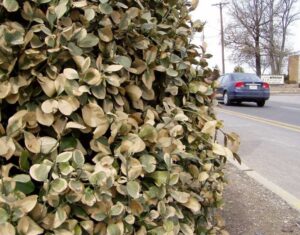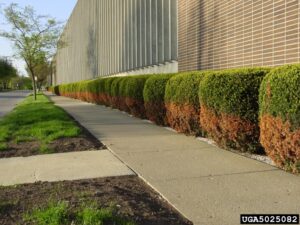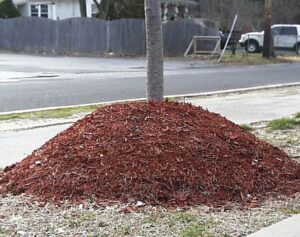What Effect Will a Cold Winter Have on Insect Populations This Season?: Insects overwinter in all life stages, but the majority are in the egg or pupa stage. Cold weather usually has little effect on these stages. Those that overwinter as adults or larvae usually overwinter in protected locations. Snow cover can insulate insects and increase survival. The major cause of decreasing insect numbers is widely fluctuating temperature extremes throughout the winter. When temperatures warm, insects begin development, only to stop when temperatures again drop. Therefore, springs with false “starts” are more likely to negatively affect insect populations than a steady cold winter.
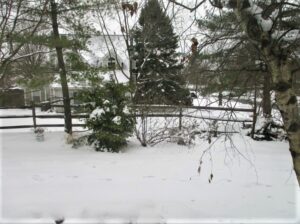
Snow cover can insulate insects & increase winter survival rates. (Photo Credit: Steven K. Rettke, Rutgers Coop. Ext.)
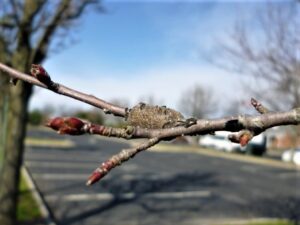
Springs with “false starts” can be detrimental to early hatching Eastern Tent Caterpillars. (Photo Credit: Steven K. Rettke, Rutgers Coop. Ext.)
Winter Storms: Severe winter storms (“nor’easters”) may cause flooding in coastal areas. Some plants can tolerate flooded or waterlogged soil, such as green ash, deciduous holly, red maple, and red osier dogwoods. Others are intolerant of flooding: European mountain ash, basswood, beech, birch, cedar, crabapple, American holly, dogwood, forsythia, hawthorn, hemlock, black locust, Norway maple, white oak, white pine, privet, redbud, sassafras, sourwood, spruce, tulip tree, black walnut, yellowwood, and yew. During the winter months, dormant plants, no matter how intolerant, can tolerate flooding or waterlogging for several weeks without much damage.

Most tree species cannot tolerate prolonged periods of flooded or water-logged soils. (Photo Credit: Steven K. Rettke, Rutgers Coop. Ext.)

This nursery has a low-lying perennial wet area that does not allow for tree survival. (Photo Credit: Steven K. Rettke, Rutgers Coop. Ext.)
All Mulches Are Not Created Equal: Although the mulching of trees and shrubs is an important plant health care practice, their effects can sometimes produce unexpected consequences. Different mulching materials should influence supplemental fertilizer practices. Nitrogen fertilizers can be applied to help reduce nitrogen immobilization where wood pallet or hardwood bark is found. Alternatively, where plants are growing in composted mulches, nitrogen application rates need to be adjusted to avoid over-stimulation. Over fertilization, especially with high nitrogen, may decrease mycorrhizae.
It is most important to use these products when trees are first planted. If raw or fresh mulches are used, they are best applied in the late fall or winter to reduce their initial negative effects on plant growth and health. As soon as the organic matter is partially decomposed and the competition for nutrients begins among soil microorganisms, then the beneficial effects can begin.
Composted leaf and twig litter are best because they will support the growth of mycorrhizae. In natural forests where there is decaying leaf litter, the non-woody roots, and especially mycorrhizae, will be abundant in the highly organic top layer of soil. In cities, more composted wood and leaves should be added in correct quantities to soil about the base of trees.
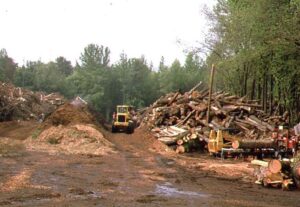
Mulch production facility: Chipping tree logs & placing them in composting piles. Notice steam rising from pile at left. (Photo Credit: Steven K. Rettke, Rutgers Coop. Ext.)
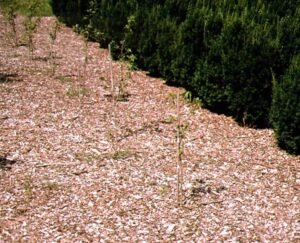
Nitrogen fertilizers were applied to this non-composted mulch used for erosion control at this nursery . (Photo Credit:Steven K. Rettke, Rutgers Coop. Ext.)
Gouty & Horned Oak Galls: These woody galls are up to 2 inches in diameter and are formed on branches of many oaks. Large galls may girdle branches and cause significant dieback. They are caused by female wasps emerging from old galls in late May. They lay eggs in oak leaves and the hatched larvae feed and cause a blister-like gall to form along the leaf vein. In July, adults emerge again and lay eggs in twigs. The familiar woody galls will grow on these twigs over a period of 2 to 3 years.
Although pruning out galls is the only recommended control, realistically it is not highly effective since it is hard to get rid of all the over-wintering galls in the area. Contact insecticides will kill emerging adults, yet timing and coverage is difficult, so overall control is minimal. Since most wasp attacks are at the tips of trees, leaf expansion makes it difficult to provide an effective pesticide residue. Multiple spray applications over a two-year period have shown some success, but exact timing is necessary. Trunk injections using both Avid and Bidren at oak bud leaf expansion have provided controls of greater than 95%. Note that when control is less than 95%, high pest levels usually reoccur. Trunk injections of imidacloprid (Merit) have shown suppression levels of only 50% or less. All the trunk injection materials listed above were applied at oak bud leaf swell.
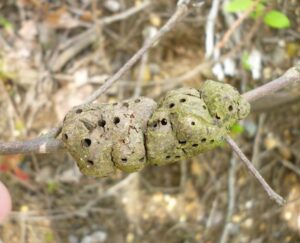
Gouty Oak Gall with exit holes created by emerged adult wasps. (Photo Credit: Steven K. Rettke, Rutgers Coop. Ext.)
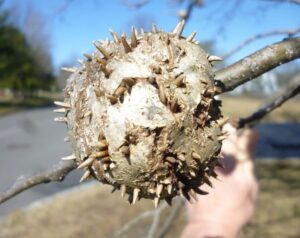
Horned Oak Galls with “horns” created by emerged adult wasps. (Photo Credit: Steven K. Rettke, Rutgers Coop. Ext.)
Blacklegged Ticks (= Deer ticks): Tick Warnings: The adults are active all winter long, when temperatures are over 32°F. The black, poppy-seed sized ticks with brick red abdomens have been searching for animal hosts since October, and will continue to do so until early May, when they will lay eggs. Take precautions during warm periods this fall/winter when working outdoors, particularly near wooded areas.
The ticks are picked-up by brushing against low (4”-6”) vegetation. Since ticks do not fly or drop from trees, they crawl up and wait on vegetation for a person to walk by and then grasp onto clothing to crawl up. Tucking your pants into your socks (so they do not crawl up your leg undetected), wearing high rubber boots (too slippery to crawl up?), and wearing a repellent (to kill them upon clothing contact) are thus all precautionary recommendations to prevent a tick bite.
The ticks prefer to live in the woods, or in adjacent vegetation, not in properly mowed lawns. Some research shows that 84% of tick stages are found in the woods, 13% along wood-edged vegetation, and only 3% in the lawn. Reliable control of Blacklegged tick nymphs is achieved with a single application during late May or the first week of June. The use of a granular insecticide (e.g., Sevin G) broadcast 8-12 feet into the woods & on shaded turf adjacent to the woods has given >95% control of nymphs. (Ref. Rutgers Landscape IPM Notes, Deborah Smith-Fiola, former Rutgers Ag. Agent.)
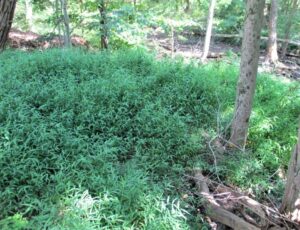
Ideal habitat for the Blacklegged Tick species. Shaded, woody area with 4-6 inches of vegetation cover. (Photo Credit: Steven K. Rettke, Rutgers Coop. Ext.)
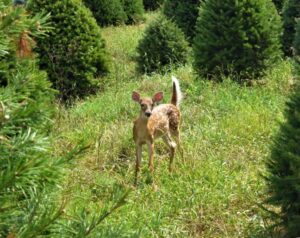
Surprised young deer at a X-mas tree farm. Deer are the ultimate Blacklegged Tick magnet. (Photo Credit: Steven Rettke, Rutgers Coop. Ext.)
Future Effects of De-Icing Salt on Plants: Winter snow falls, and icy roads & sidewalks create the need for the increased use for deicing salts. The most used salts are sodium chloride and calcium chloride. Sodium chloride is commonly called rock salt and is more damaging to plants. Calcium chloride is a better material for melting, but more expensive and harder to handle. Both products are usually mixed with abrasives (sand, gravel, or sawdust) that accumulate along roadways and may cause drainage problems.
Adjacent plants become injured by salt when roots encounter salt-laden water. The damage symptoms include stunted leaves, heavy seed loads, twig and branch dieback, leaf scorch, and premature leaf drop. A general unthrifty appearance and poor growth is also a typical symptom. Plants may show symptoms of K & P deficiencies. Conifers tend to suffer damage from accumulated salt more easily than do deciduous plants.
The best solution to the problem is to prevent salt buildup in the first place, if possible. Suggest that your clients use abrasives (kitty litter, sand) instead of salt when treating driveways and walkways. Anti-desiccants can also prevent injury, especially on evergreens. After the fact, leach the salt with fresh water as soon as possible following exposure. Gypsum can also be applied: incorporate into the topsoil surface under the plant canopy at the rate of 50-lb./1000 square feet.
Voles (Meadow Mice): A common animal pest in the landscape, they feed on everything from bulbs, perennials, trees, and shrubs. They typically feed on roots and cause girdling to woody stems. Voles range in size from 3” to 5” long, with a 1-2” tail. Voles have both surface and underground tunnels (within 1-2” of the surface), pushing soil out of the tunnels after burrowing for short distances. Voles are most active in early morning and evening yet will feed throughout the day.
Do not give voles winter protection by placing mulch up against the base of the tree. Keep mulch thickness less than 2-3 inches. Protect young trees by placing tree guards around the trunks, sinking the guard at least 6” below the ground. During the growing season, manage voles by mowing vegetation around trees and shrubs, and raking up leaves in the fall.
